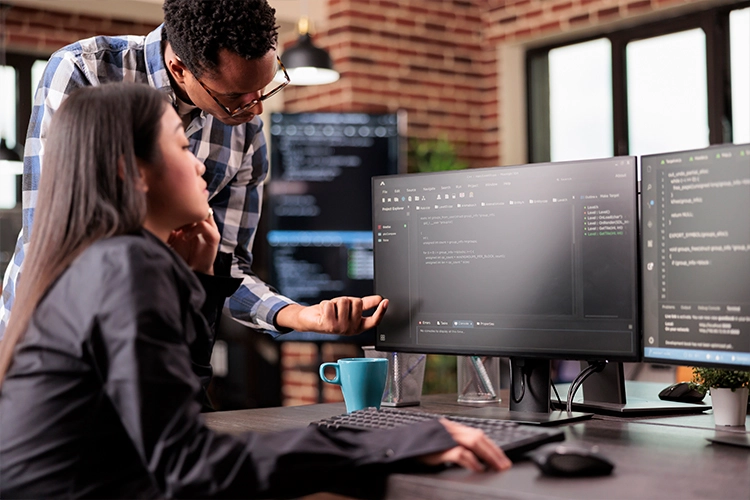Top 10 Front-End Frameworks for Modern Web Development

In today’s digital landscape, front-end development stands at the forefront of innovation, enabling the creation of dynamic, responsive, and visually stunning web applications. With an array of front-end frameworks available, software developers have a wealth of options to choose from when embarking on modern web development projects.
These frameworks not only streamline the development process but also empower developers to build sophisticated user interfaces with efficiency and scalability. In this comprehensive guide, we’ll explore the top 10 front-end frameworks that are shaping the future of web development, highlighting their features, benefits, and suitability for various project requirements.
Whether you’re a seasoned developer or just starting your journey in web development, understanding the landscape of front-end frameworks is essential for building cutting-edge applications that resonate with today’s users. Join us as we delve into the world of front-end frameworks and uncover the tools that are driving innovation in modern web development.
Why Choosing Framework Matter?
Choosing the right front-end framework for your web development project is a decision that can significantly impact the success and efficiency of your offshore development process. Here’s an expanded look at why this choice matters:
Productivity
Front-end frameworks come equipped with pre-built components, libraries, and tools that streamline the development process. These resources allow developers to focus more on implementing business logic and user experience enhancements rather than spending time on repetitive tasks like building UI components from scratch or handling cross-browser compatibility issues. Consequently, the right framework can dramatically increase productivity, enabling faster development cycles and quicker time-to-market for your applications.
Consistency and Maintainability
Frameworks enforce coding standards, architectural patterns, and best practices, ensuring consistency across your project. By following a standardized approach to development, team members can easily understand each other’s code, collaborate more effectively, and maintain the application more efficiently over time. This consistency also minimizes the likelihood of introducing bugs or inconsistencies as the project evolves, leading to a more stable and reliable codebase.
Performance Optimization
Many front-end frameworks incorporate performance optimization techniques to enhance the speed and responsiveness of web applications. Techniques such as virtual DOM rendering, code splitting, lazy loading, and tree shaking help minimize the initial load time, reduce resource consumption, and improve overall application performance. By leveraging these optimizations, developers can create web applications that deliver a seamless and engaging user experience, even on low-powered devices or slow network connections.
Scalability and Flexibility
The right front-end framework should be capable of scaling with your application as it grows in complexity and functionality. A well-designed framework provides a modular architecture that allows developers to organize code into reusable components, manage state effectively, and integrate with other tools and libraries seamlessly. This scalability ensures that your application remains maintainable and performant, even as you add new features, accommodate increasing user traffic, or expand to support additional platforms or devices.
Community and Ecosystem
Popular front-end frameworks often have large and active communities of developers, contributors, and enthusiasts. These communities provide valuable resources such as documentation, tutorials, forums, and third-party plugins or extensions that can accelerate development, troubleshoot issues, and foster knowledge sharing. By choosing a framework with a vibrant community, developers can tap into a wealth of collective expertise, stay updated on industry trends, and address challenges more effectively throughout the development lifecycle.
Cross-Platform Compatibility
With the proliferation of devices and platforms, ensuring cross-platform compatibility is essential for reaching a diverse audience and maximizing the reach of your web applications. Many front-end frameworks offer built-in support for responsive design, progressive web app (PWA) features, and native app development through technologies like React Native or Ionic. By leveraging these capabilities, developers can create web applications that adapt seamlessly to various screen sizes, input methods, and device capabilities, providing a consistent and engaging user experience across desktops, tablets, smartphones, and other devices.
How to Choose the Right Framework for Your Project?

Choosing the right front-end framework for your project is a decision that requires careful consideration of various factors to ensure compatibility, efficiency, and long-term success. Here’s an expanded guide on how to choose the right framework for your project:
Project Requirements Assessment
Begin by thoroughly understanding the requirements of your project. Consider factors such as the complexity of the application, its intended functionality, target audience, and scalability requirements. For instance, a simple marketing website may have different needs compared to a complex web application with real-time data processing and dynamic user interactions.
Evaluation of Learning Curve
Assess the learning curve associated with each front-end framework and consider the skill level of your development team. Some frameworks, like Vue.js, are known for their simplicity and gentle learning curve, making them ideal for beginners or teams with limited experience. On the other hand, frameworks like Angular may have a steeper learning curve but offer more comprehensive features and capabilities once mastered.
Performance Considerations
Evaluate the performance characteristics of each framework, including rendering speed, bundle size, and optimization techniques. Look for frameworks that employ efficient rendering mechanisms, such as virtual DOM or server-side rendering, to minimize load times and improve responsiveness. Additionally, consider the impact of the framework on factors like SEO and accessibility, as these can significantly affect the user experience and discoverability of your application.
Community Support and Documentation
Research the community support and documentation available for each framework. A strong community can provide valuable resources, support forums, tutorials, and third-party plugins or extensions that simplify development and troubleshooting. Look for frameworks with active communities that regularly contribute updates, bug fixes, and improvements to ensure ongoing support and longevity.
Compatibility with Existing Stack
Consider the compatibility of the framework with your existing technology stack, including backend technologies, databases, and additional libraries or frameworks. Choose a front-end framework that integrates seamlessly with your current tools and infrastructure to minimize compatibility issues and streamline development workflows. For example, if you’re using Node.js on the backend, consider frameworks like React or Vue.js that offer server-side rendering capabilities and support for server-side JavaScript execution.
Long-Term Viability and Roadmap
Evaluate the long-term viability of each framework by examining its adoption rate, release cycle, and development roadmap. Choose frameworks with a proven track record, active development community, and regular updates to ensure ongoing support, security patches, and compatibility with emerging web standards. Additionally, consider the stability and maturity of the framework, as well as its alignment with your project’s long-term goals and technology roadmap.
Flexibility and Customization
Consider the flexibility and customization options offered by each framework to accommodate the specific requirements and design preferences of your project. Look for frameworks that allow for easy customization of styles, layouts, and functionality without compromising performance or maintainability. Additionally, assess the extensibility of the framework through plugins, themes, or third-party integrations that can enhance its capabilities and adapt to evolving project needs.
Feedback from Peers and Industry Experts
Seek feedback from peers, industry experts, and online communities to gather insights and recommendations on the best front-end frameworks for your project. Consider case studies, reviews, and testimonials from developers who have used the frameworks in similar projects or contexts. Engage in discussions, attend conferences, and participate in online forums to gain valuable insights and perspectives that can inform your decision-making process.
What are the Top 10 Front-End Frameworks for Modern Web Development?

The landscape of front-end development is rich with choices, but certain frameworks have risen to prominence due to their robust features, extensive community support, and proven track records in modern web development. Here’s an expanded overview of the top 10 front-end frameworks:
React
- Developed by Facebook, React is a JavaScript library for building user interfaces, particularly single-page applications (SPAs).
- React’s component-based architecture and virtual DOM make it highly efficient for creating interactive and dynamic UIs.
- It offers features like JSX for declarative component syntax, state management with hooks or Redux, and server-side rendering with frameworks like Next.js.
- React’s large community and ecosystem provide developers with a wealth of resources, including libraries, tools, and tutorials.
Angular
- Developed and maintained by Google, Angular is a comprehensive front-end framework for building SPAs and enterprise-scale applications.
- Angular’s opinionated approach emphasizes features like two-way data binding, dependency injection, and modular architecture.
- It provides a powerful CLI for scaffolding projects, robust routing capabilities, and built-in support for forms, HTTP requests, and internationalization.
- Angular’s ecosystem includes tools like Angular Material for pre-designed UI components and Angular Universal for server-side rendering.
Also Read Our Page : Angularjs Development Services
Vue.js
- Vue.js is a progressive JavaScript framework known for its simplicity, flexibility, and ease of integration with existing projects.
- Vue’s reactive data binding and component-based architecture make it intuitive for developers to build complex UIs with minimal overhead.
- It offers features like Vue Router for client-side routing, Vuex for state management, and Vue CLI for project scaffolding and build configuration.
- Vue’s ecosystem includes libraries like VueX for state management, Vue Router for routing, and Vue Test Utils for unit testing.
Svelte
- Svelte is a relatively new framework that takes a different approach to building UIs by shifting much of the work to compile time.
- It allows developers to write expressive components using a simple syntax and compiles them into highly efficient JavaScript code at build time.
- Svelte’s reactive updates and minimal runtime overhead result in smaller bundle sizes, faster loading times, and improved performance compared to traditional frameworks.
- It offers features like reactive declarations, component-based architecture, and built-in animations/transitions.
Bootstrap
- Bootstrap is a popular CSS framework for building responsive and mobile-first websites with a consistent design language.
- It provides a comprehensive set of pre-styled components, utilities, and layout grid systems that streamline the development of UIs.
- Bootstrap’s extensive documentation and customization options allow developers to create visually appealing designs while adhering to accessibility and responsive design best practices.
- It offers features like responsive grid system, pre-designed UI components, and custom CSS utilities.
Tailwind CSS
- Tailwind CSS is a utility-first CSS framework that provides a set of low-level utility classes for building custom designs without writing custom CSS.
- It allows developers to style UI elements using utility classes like padding, margin, typography, and color, resulting in highly customizable and maintainable code.
- Tailwind’s approach to CSS encourages consistency, flexibility, and rapid prototyping while minimizing the need for manual CSS overrides.
- It offers features like utility classes for styling, responsive design utilities, and customization through configuration files.
Foundation
- Foundation is a responsive front-end framework developed by ZURB, offering a robust grid system and a comprehensive set of UI components.
- It provides pre-designed components for navigation bars, buttons, forms, and other common UI elements, along with built-in support for accessibility and customization.
- Foundation’s modular architecture allows developers to pick and choose components based on project requirements, reducing bloat and optimizing performance.
- It offers features like responsive grid system, customizable UI components, and built-in accessibility features.
Material-UI
- Material-UI is a React component library that implements Google’s Material Design principles, offering a wide range of pre-designed UI components.
- It provides components like buttons, cards, menus, and dialogs, all following the Material Design guidelines for consistency and visual appeal.
- Material-UI’s components are highly customizable and themable, allowing developers to create unique designs while maintaining adherence to Material Design standards.
- It offers features like pre-designed Material Design components, theming support, and integration with React applications.
Ember.js
- Ember.js is a framework for building ambitious web applications with a focus on convention over configuration and developer productivity.
- It provides features like two-way data binding, routing, and a powerful templating engine, along with a CLI for project scaffolding and automation.
- Ember’s convention-based approach encourages best practices and consistency across projects, making it ideal for teams working on large-scale applications.
- It offers features like convention over configuration, Ember CLI for project automation, and Ember Data for managing application state.
Ionic Framework
- Ionic is a cross-platform framework for building mobile applications using web technologies like HTML, CSS, and JavaScript.
- It leverages web views to render native-like UI components across multiple platforms, including iOS, Android, and the web.
- Ionic’s UI components are optimized for touch interactions and provide a consistent look and feel across platforms, helping developers create engaging mobile experiences.
- It offers features like pre-designed UI components, native app integrations, and tools for building progressive web apps (PWAs).
Each of these frameworks offers unique features, advantages, and use cases, so it’s essential to evaluate them based on your project requirements, team expertise, and long-term goals. By choosing the right framework and leveraging its capabilities effectively, developers can streamline development workflows, improve productivity, and deliver exceptional user experiences in modern web applications.
Conclusion
Front-end frameworks play a crucial role in modern web development, offering developers the tools and resources needed to build responsive, interactive, and scalable applications. When choosing a framework for your project, consider factors such as project requirements, learning curve, performance, community support, compatibility, and long-term viability. By selecting the right framework and leveraging its features effectively, you can streamline development workflows, improve productivity, and deliver exceptional user experiences. Whether you opt for React, Angular, Vue.js, or any other framework on this list, each offers unique advantages and capabilities to suit a variety of projects and development preferences.
Ready to embark on your next web development journey? At Imenso Software, we specialize in crafting bespoke web solutions tailored to your specific needs. Contact us today to discover how our expertise and innovative approach can elevate your project to new heights. Let’s build something extraordinary together.
We’re honored to mention that our efforts have been recognized by renowned B2B review and research platforms such as GoodFirms, Clutch, MirrorView, and many more.
Want more information about our services?
Similar Posts

9 Secrets to Extraordinary Web Development in 2024 with Laravel
Often, one may be left wondering what exactly comes as a difference between a good and a great web application. The answer certainly lies in these minute details, slight subtleties, and constant improvements in the framework chalked out at its core. This has been a powerful channel in web development, whereby developers get flexible and […]...

What is a CRM? And How Does it Help in Cutting Business Costs?
Do you how much money is lost due to poor customer service every year? $1.6 Trillion! Poor customer service may result because of various reasons, but the most common is that businesses fail to understand their customer’s needs and expectations. Are there always some unhappy customers present? True, but they are just a minute percentage […]...

React.js Hooks: Simplifying State Management in Your Applications
React.js has emerged as a dominant player in front-end web development, empowering developers to create dynamic and interactive user interfaces. As applications grow in complexity, so does the challenge of managing the state effectively. Traditionally, React class components were used for state management, but with the introduction of React Hooks, the process has become simpler […]...









